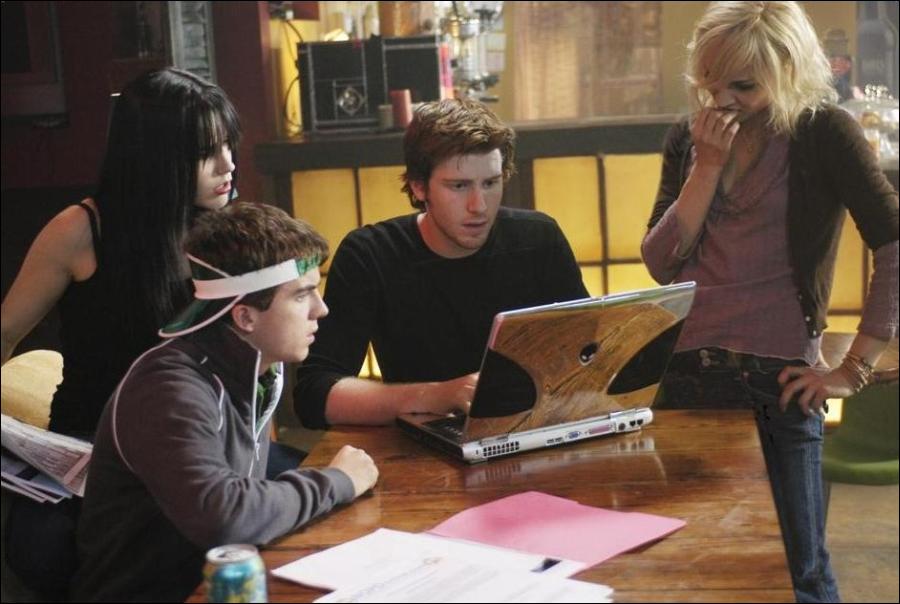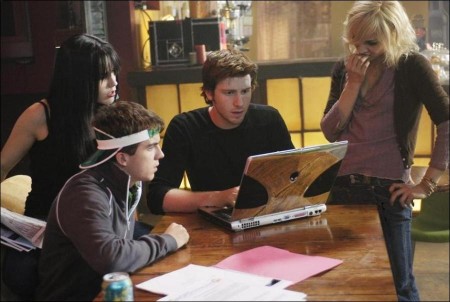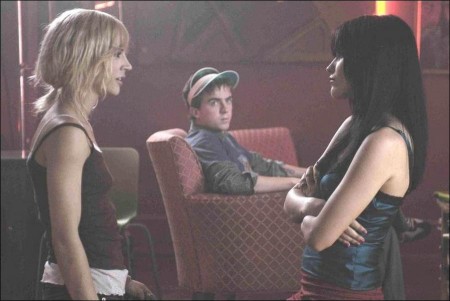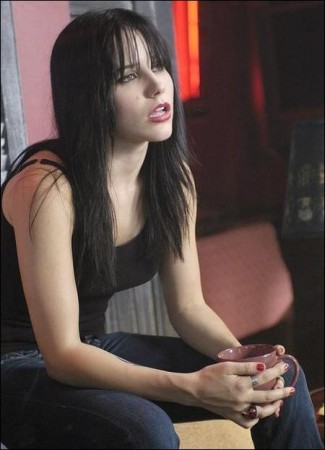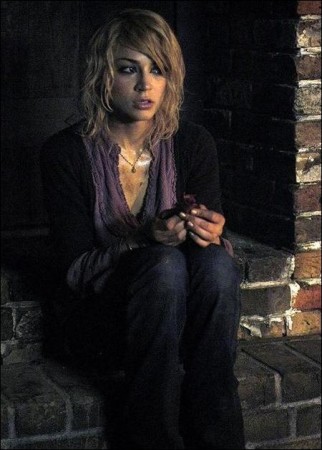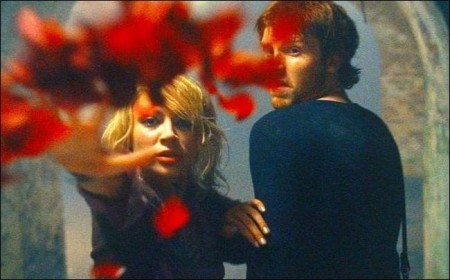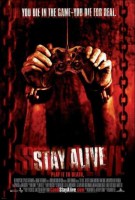Tagline: Play It To Death.
When a group of teenagers begin to play an ultra-realistic videogame called Stay Alive they soon discover a spine-chilling connection — they are each being brutally murdered one-by-one in the same method as the character they played in the game. As the line between the game world and the real world disappears, the group must find a way to Stay Alive.
After the mysterious brutal death of an old friend, a group of teenagers find themselves in possession of Stay Alive, a next generation horror survival videogame based on the spine-chilling true story of a 17th century noblewoman known as “The Blood Countess.” The gamers don’t know anything about the game other than they’re not supposed to have it… and they’re dying to play it.
Not able to resist temptation, the group begins to play the grisly game and soon a chilling connection is made – they are each being murdered one-by-one in the same method as the character they played in the game. As the line between the game world and the real world disappears, the group must find a way to defeat the vicious and merciless Blood Countess, all the while trying to… Stay Alive.
The Game Everyone’s Dying to Play
When brand-new law clerk and long-time gamer Hutch MacNeil finds a simple, hand-labeled disk among the possessions of a friend who was tragically murdered, he knows exactly what it must be. It’s an underground copy of a hot new videogame that hasn’t yet hit the shelves.
Devastated by his friend’s death, yet unable to resist such contraband, Hutch can’t help but share it with his close-knit group of gamer friends – including 21 year-old Goth vamp October, her punky older brother Phineus, their tech-wiz friend Swink and the group’s newcomer, the shy shutterbug Abigail. They all know they shouldn’t even have the game, but that just makes it even more exciting to play.
Right from the start, this game is different from any other and they’ve played them all – “Splinter Cell,” “Silent Hill,” “Halo” and the list goes on. But “Stay Alive” is the most intensely scary, most technologically advanced and most obsessive horror survival game they’ve yet encountered. Taking place in New Orleans’ creepy Gerouge Plantation, a sprawling Southern estate where a group of young women has gone missing, the game’s objective is simple – unravel the haunting mystery of the missing girls and, most of all, stay alive. But the latter turns out to be far more challenging than anyone expected.
Of course, video game characters die all the time, and when they do, you simply start the game all over again. But when the first person whose character dies in “Stay Alive” is actually found dead, savagely attacked in reality, suspicion begins to mount. If you die in the game… will you die in real life? And who is doing the killing? Is it one of the gamers? A dangerous outsider? The game itself? As both the threat and paranoia grow, the play turns deadly serious and the gamers must turn their keen cyber-survival skills to unraveling a real life mystery that could truly mean “game over.”
What happens when the thin line between life and games becomes completely blurred? That was the explosive question that the co-writers of STAY ALIVE, William Brent Bell, who also directs, and Matthew Peterman had in mind as they decided to create an entirely new and different kind of horror legend for their game-loving generation. Avid gamers themselves, they had a vision for blending the wild graphics and action of video games with the psychological thrills of a horror movie in a way that hadn’t been done before — forging what they hoped would be a uniquely visceral and utterly 21st century experience.
It was a vision so new and innovative, just a few years ago they couldn’t get anyone interested in it. But as videogames have continued to explode in popularity, their concept became more and more intriguing to Hollywood – soon drawing the eye of forward-looking, youth-oriented director and producer McG (“Charlie’s Angels,” “The OC”), who passionately threw his support behind the project. Soon after, STAY ALIVE went into development with three major Hollywood forces behind it: McG’s Wonderland Sound and Vision, the leading feature film companies Spyglass Entertainment and the innovative Endgame Entertainment.
“Matt and I had felt for a long time that teen audiences were truly ready for a movie using a videogame as a story engine, but it took awhile to convince other people,” explains William Brent Bell. “It’s something no one’s really done this way before. In this day and age, when games are so rich with story and characters, it really made sense to us to bring the two forms together. Movies and games each have their own way of telling stories, but the marriage of the two is something we really believed in, something that we felt like we understood and could turn into a powerful experience.”
Having been inside the gamer culture themselves, Bell and Peterman knew the heart of the story would be a typical group of young friends caught up in a gaming mystery that becomes ever and ever more real. “When young audiences watch a film with a young cast who they can really relate to, they start to live vicariously through those characters and get much more scared by what they’re going through,” notes Bell. “So we tried to create characters right out of everyday experience – not your stereotypical jocks and cheerleaders but a group who are intelligent, funny, emotional and act as the kind of surrogate family that a lot of young adults today are for each other.”
Even before they started writing, Bell and Peterman started hanging out in gaming cafes on a regular basis to soak up the subculture’s distinctively sharp language, laissez faire style and intense atmosphere. “We play a lot of games ourselves of course but we also wanted to research as how kids are talking, dressing and playing games right now. We wanted to capture how they interact with each other, how intense they are,” says Peterman. “Basically, we wanted to get inside the gamers’ world as completely as we could.”
To provide even keener creative insight into the highs and lows of gaming life, the filmmakers brought in consultant CliffyB, a leading innovative game designer who has been deeply involved in the development of the “Unreal Tournament” franchise and recently designed the dark and scary “Gears of War” for the XBox 360. As the script was developed, CliffyB provided sage answers to questions ranging from up-to-the-minute gamers’ vocabulary to specific game tactics. “Cliffy was basically our sounding board,” explains Peterman. “If we had a question about lingo or game strategy he was the guy we went to and he gave us a lot of input that really upped the credibility of the game.”
As they explored the story deeper, Bell and Peterman also found themselves dancing carefully through the surreal zone where reality and fantasy bleed into each other. It was a place they found dark and lined with pitfalls, but definitely inspirational. “We had a lot of fun because we were able to really play around with time and space, to break all the usual rules,” says Bell. “At times in the story, reality is mirroring the game and at other times the game is mirroring reality and then the two converge together to make this fusion type world that was fantastic to imagine and not like anything else we’d ever seen. It could also get very scary, even for us.”
When Bell and Peterman’s edge-of-your-seat screenplay fell into the hands of McG things really began to take off. Impressed with the strength of their vision, McG strongly supported the idea of William Brent Bell taking the helm of the movie. “We believed in these guys” explains co-producer David Manpearl, who works with McG at Wonderland. “They have such young, fresh voices, they’re completely tapped into youth culture and they look at things differently, which is what we are all about at Wonderland. We also thought the idea of mixing videogames and horror, two of the most popular entertainment forms today, was a great one.”
McG in turn brought in Peter Schlessel, former head of Columbia Pictures, who also joined the project as a producer. “When McG showed me the screenplay, it just screamed out to me that it was a great idea,” says Schlessel. “I liked the voices of the characters and how timely a subject it was. Anytime you can tell a horror story that involves what’s going on right now in youth culture, that’s a compelling thing. STAY ALIVE takes something that most kids do every single day, that’s a major part of their lives, and turns it into something terrifying. I thought it would be great, fun entertainment inspired by something very true-to-life.”
Schlessel did not balk at the idea of neophyte Bell directing the destined-to-be-complex production. “With William and Matthew you clearly had the voices of two writers who really knew what they wanted to accomplish on the screen,” he notes. “We also had a huge safety net in McG, who’s one of the greatest guys in the business, and who personally committed himself to supporting these guys. I knew McG was the perfect mentor to guide them through the rough spots of making the film and that gave me a lot of confidence. Then, you have two leaders in filmed entertainment – Spyglass and Endgame – coming on board, so there was a lot of strength behind it from the start.”
As deals fell into place and development began in earnest, Bell and Peterman were awestruck by all the support they received. “This was our very first feature film, so were really excited to have so many great people and companies involved. McG, Wonderland, Spyglass, Endgame — they really believed in us, which was awesome,” says Bell.
As a director, Bell looked for further inspiration in the classics of the horror genre, the films that took fear to the next edge for previous generations including “The Shining,” “The Omen” and “Rosemary’s Baby.” “What I loved about those movies is the pacing,” Bell comments. “My idea for STAY ALIVE was to do something that would merge that classic quality with the more comedy-filled MTV-style horror movie of today. So in STAY ALIVE, we build the pace slowly with shots of long halls and cracked open doors and that type of psychological fear but there’s also a lot of pay off with fastmoving, graphic, bloody scenes that will shock you.”
When it came to designing the look and feel of the game “Stay Alive,” Bell and Peterman knew they’d be behind the curve even if they used today’s most sophisticated and cutting-edge games as a template. Instead, with CliffyB and others as their guides, they chose to look ahead to what the next generation of video games is likely to look and feel like. “In designing the game, we basically took what games are able to do right now and multiplied that by three,” says Peterman. “What you see in this movie is probably what games will really be like in just a few years. We went to the edge of what people in the gaming industry expect will be possible.”
The Real-Life Legend Behind the Game
The game of STAY ALIVE chills the blood and pumps the adrenaline of its players in part because it based on a story of murder and bloodthirsty madness that is itself disturbingly and hauntingly real. At the center of the game’s action is an actual historical figure who was quite possibly the world’s most prolific serial killer ever: Elizabeth Bathory, the alluring 17th century aristocrat whose bizarre thirst for human blood garnered the nickname “The Blood Countess.” Bathory’s almost unspeakably depraved biography remains a chilling reminder that within humanity, evil monsters lurk in all guises.
Explains Matthew Peterman: “Brent and I both felt strongly that the very scariest stories you can tell almost always come from real people and incidents. So we started looking into historical figures who were considered particularly mean and nasty and that’s we came across probably one of the scariest and nastiest women who ever lived: Elizabeth Bathory. Her story still haunts anyone who hears it.”
Adds William Brent Bell: “With Elizabeth Bathory, we felt like we found a new kind of horror icon, someone far more sophisticated than the typical guy in the mask chopping up teenagers, and someone who could really drive this story because she’s not just a made-up character in a videogame – she’s someone from history who remains truly frightening and gruesome.”
Born into a powerful noble family in the 17th Century, Elizabeth Bathory started out with every advantage. She was rich, well educated and a renowned beauty said to have been possessed of glowing raven hair and pale, luminous skin. Married off for political reasons at the age of 15, Elizabeth instantly became the Countess of Transylvania (where Count Vlad Dracula had ruled a century before) and was whisked to a mountain-top fortress in the Carpathians, where she was installed as the Lady of the Castle of Csjethe. There, while her soldier husband (himself known as “The Black Hero of Hungary”) was away on various war campaigns, a bored and alienated Elizabeth searched for ways to amuse herself. Drawn to the darker side of life, she took up the study of “the sinister arts” and, as a hobby, began gleefully torturing local debtors in the castle dungeons.
But it was after her husband’s death that things took an even grimmer turn. In an increasingly desperate effort to maintain her waning youth and vitality, history has it that Elizabeth made the accidental and unfortunate discovery that fresh blood could purify and smooth her skin. Thus, she began a ruthless rampage through the countryside, kidnapping, torturing and killing numerous young peasant girls in order to bathe in their moisturizing blood. To create an even steadier supply of virgins for bloodletting, she later opened up a school in her castle, taking in 25 girls at a time from rich families, who were subjected to unsettling cruelties and mass fatalities.
It was a mistake. Though the deaths of impoverished peasant girls might have been overlooked by the authorities, the murder of noble children was not. Soon, rumors of Elizabeth’s terrible crimes began to spread. Forced to act, the Hungarian Emperor, Matthias II, mounted an investigation, which turned up rooms of lavish torture racks and mutilated, bloodless corpses in Elizabeth’s castle. Elizabeth was put on trial, but refused to attend the proceedings, ultimately admitting nothing about the 650 missing girls of whom she was suspected of killing.
In the end, the Countess’s alleged accomplices were all convicted of being witches and executed, but Elizabeth herself escaped that fate due to her noble birth. She was never even convicted. Instead, she was declared a menace by her family and condemned to live walled up inside her castle, driven insane by solitude, for the rest of her days. It is assumed she died there – but in STAY ALIVE it appears Elizabeth’s spirit was able to escape and set up a new lair across the oceans in another famed haunt of vamps and vampires: the city of New Orleans.
Today, the Blood Countess is considered one of history’s first and most voracious serial killers and an inspiration for numerous vampire legends, including the creation of “Dracula” by Bram Stoker. Although a few contemporary novels and comic books have been written about the Blood Countess, her legend primarily faded into obscurity – another reason why Bell and Peterman felt she would make the perfect villain at the heart of STAY ALIVE.
Bell summarizes: “When we started reading about Elizabeth Bathory, it was like ‘why haven’t we ever seen a movie about her? She’s so dark and fascinating and she’s absolutely real. Virtually everything she does in the movie is based on things she actually did according to various histories, which gives it all a very chilling power that affected us even on the set.”
These production notes provided by Spyglass Entertainment.
Stay Alive
Starring: Jon Foster, Samaire Armstrong, Frankie Muniz, Sophia Bush, Adam Goldberg
Directed by: William Brent Bell
Screenplay by: William Brent Bell, Matthew Peterman
Release Date: March 24, 2006
MPAA Rating: PG-13 for horror violence, disturbing images, language, brief sexual and drug content.
Studio: Spyglass Entertainment
Box Office Totals
Domestic: $23,086,480 (85.2%)
Foreign: $4,018,615 (14.8%)
Total: $27,105,095 (Worldwide)
